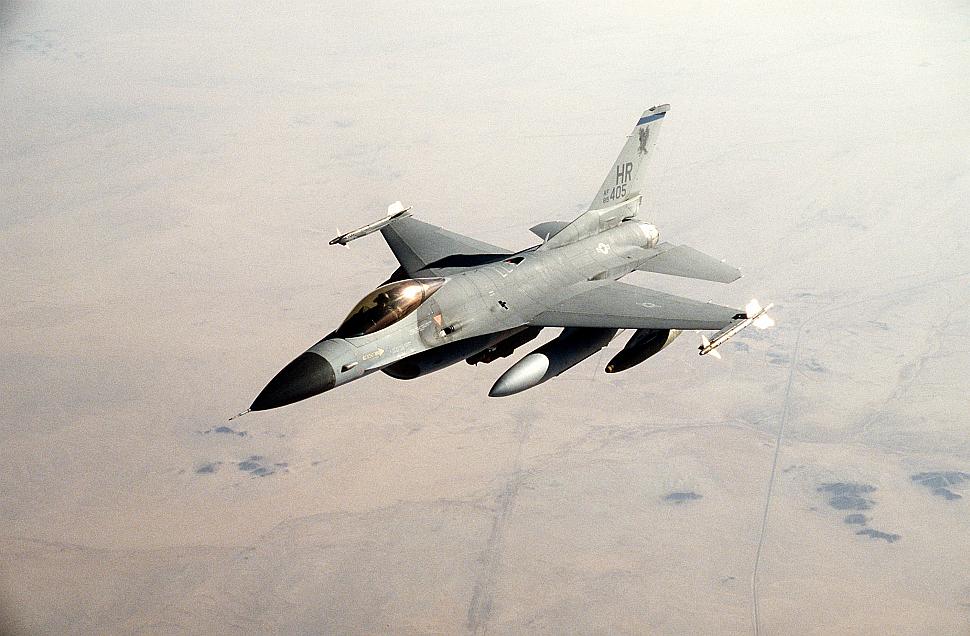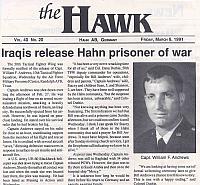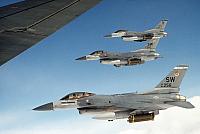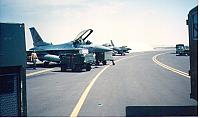Fighter Jet News
F-16 Fighting Falcon News
50th TFW fights in Desert Shield & Desert Storm
February 19, 2009 (by
Randolph Saunders) -
As Saddam Hussein refused to comply with United Nations Security Council resolutions to remove his military forces from Kuwait by Jan. 16, 1991, the 50th TFW deployed to Saudi Arabia to join coalition forces gathering to enforce security council resolutions.

Thirty F-16Cs left Hahn Air Base for Zaragoza, Spain, on Dec. 29, 1990. Scheduled to continue to the United Arab Emirates on the following day, heavy fog at Zaragoza delayed the 10th Tactical Fighter Squadron's crews. While hundreds of personnel at Zaragoza celebrated and welcomed the New Year holiday, 30 pilots of the 50th Tactical Fighter Wing fired their afterburners, and lifted into the darkness bound for the Middle East and the near certainty of combat.
Arriving at their Saudi Arabian base only two weeks before the Jan. 16 deadline imposed by the United Nations, 10th TFS pilots and support personnel had little time and much to do. While pilots received initial briefings on flight operations, maintenance specialists prepared the F 16s for their next flights. Aircrews learned that they would not employ the low-level procedures they had practiced for use in central Europe. Instead, they would deliver their payloads from nearly 20,000 feet with ingress angles near 60 degrees. As training progressed, crews from the 10th began sitting alert with crews of the 17th and 33rd Tactical Fighter Squadrons, hoping that they might be the first to strike if war erupted.
Capt. Evan "Ivan" Thomas, a pilot with the 10th TFS, explained the feeling.
"Why, I'm sure you're asking yourself, would anyone want to go fly into combat, especially in the skies of today's battlefields with countless radars, heat-seeking missiles, and good, old-fashioned anti-aircraft guns?" said Captain Thomas. "It's a hard thing to explain.
"Think about whatever activity you like most in life...riding your motorcycle, or maybe just playing baseball. Now imagine that it's your job, with pay and everything. You love baseball. You've worked hard to be one of the best players, and you and your family have sacrificed a lot to get you there. You practice every day, but the practice is a little different than usual. Some days you do batting practice, but since real baseballs are expensive, you use whiffle balls to simulate real ones. Other days you work on fielding, only with half the team because the rest are simulated. When you work on base running, you have to simulate the throw to the bag, because a real throw might be dangerous.
Captain Thomas said it's like a baseball team that only gets together and plays with real bats and balls against a simulated team a few times a year. He compared it to never having actually played a real game, and finally getting the chance, with the whole country rooting for your team.
Jan. 15, 1991 passed with Al Dhafra's crews and much of the coalition forces watching events unfold on the news. International news broadcasts, beamed via satellite, told of Iraq's refusal to withdraw and the resulting discussions on how the U.N. coalition would proceed. Jan. 16, 1991 was much the same. Then, with a click of the second hand, Desert Shield became Desert Storm.
At 4 a.m. local, Jan. 17, the first 40-plane strike package left Al Dhafra for targets in Iraq. Pilots of the 10th Tactical Fighter Squadron flew their first combat sorties of the war later that afternoon, led by squadron commander, Lt. Col. Edward Houle. The assigned target for the eight-ship element of the 10th TFS, was Al Taqaddum Airfield, near Baghdad, a round-trip of more than 1,400 miles and an eight-hour mission for crews accustomed to training flights of only one to three hours.
For nearly six weeks, crews of the 10th TFS conducted attacks on Iraqi targets, including airfields, communication centers and military command centers. Iraq sent up few fighters to intercept the coalition's attackers and those that did fly were shot down or chased to the Iraq-Iran border. After the initial attacks the 10th crews received new orders. Iraq had begun using their scud missiles in retaliation against the coalition's offensive air strikes, targeting both coalition forces and Israeli civilian population centers. Israel responded to these attacks by threatening to enter the conflict, a development that would have jeopardized Arab participation in the coalition. In response, U.S. Central Command ordered search-and-destroy missions against Iraqi mobile and fixed scud launchers.
Attacking those targets put the F-16 pilots of the 10th TFS, as well as pilots of the other scud patrol aircraft, at greater risk. Not only were the launchers heavily defended, a good kill meant locating and identifying the scud's associated radar once it was activated for launch. Once located, pilots had to reach the target and make their attack while jamming Iraq's defensive radars. The squadron's first scud patrol mission began on Jan. 19, 1991, only three days into Desert Storm.
Capt. Mark Hebein, flying a lead aircraft in one of the first "scud buster" packages, described the mission:
"We are sent in a 40-ship package to western Iraq, a very long way away with no return tankers scheduled at the present time. Oh boy! Found the site we were looking for and encountered AAA, SA-2s and SA-6 SAMS. Took out three SCUDs. Getting dark now and heading for home low on gas with no place to land."
After several days of "scud busting" operations, the Al Dhafra-based fighter crews returned to offensive attacks against larger targets.
On Jan. 23, the mission again changed. With most of the strategic targets eliminated, the time had arrived to concentrate on Iraq's Republican Guard units occupying Kuwait and Iraq's southern region. At a press conference, Gen. Colin Powell, Chairman of the Joint Chiefs of Staff, explained, "Our strategy against the Republican Guards is simple. First, we cut them off, next we kill them!" For the Al Dhafra-based crews, this meant bombing any military targets on the road and destroying any pontoon bridges being constructed across the Tigris River. In addition, the wing's crews dropped leaflet bombs over Iraqi positions and civilian centers. For the next month, emphasis centered on preparing the battlefield for the eventual ground war and serving on scud alert.
When the ground war began on Feb. 25, crews began flying combat air patrols, protecting and supporting coalition ground forces. This mission, however, lasted only three days. On the morning of Feb. 28, 1991, the offensive ceased to allow Iraqi units to withdraw. The Gulf War ended. The 10th TFS lost one aircraft (#84-1390) and one pilot that had become a prisoner of war. Capt. Bill "Psycho" Andrews had been shot down and captured on the afternoon of Feb. 27. Iraqi forces provided him with no medical treatment for the broken leg he suffered while ejecting from his aircraft and he received beatings during interrogations. Fortunately, he remained a POW for only one week, released to representatives of the International Red Cross in Baghdad on March 5. Captain Andrews received the Air Force Cross for heroism on May 20, 1991.
After a brief interlude, crews returned to combat air patrols to enforce cease-fire accords that prohibited Iraqi aircraft from operating within defined areas. This provision of the cease fire sought to protect coalition ground forces, United Nations personnel who would monitor Iraq's compliance with Security Council resolutions and civilian populations. The reduced, monotonous level of activity after the hectic pace of the air war soon bored many. Crews and support personnel alike eagerly looked forward to leaving Al Dhafra for home and family.
Note: This article is part of a series on the 50th Space Wing's historical involvement in combat operations in Southwest Asia.

An air-to-air view of USAF F-16C block 25 #85-1405 from the 10th TFS armed with Mark 84 2,000-pound bombs mounted under its wings and AIM-9 Sidewinder air-to-air missiles on its wing tips during the second wave of air attacks on Iraqi targets in support of Operation Desert Storm on January 17, 1991. [USAF photo by TSgt. Perry Heimer]
Arriving at their Saudi Arabian base only two weeks before the Jan. 16 deadline imposed by the United Nations, 10th TFS pilots and support personnel had little time and much to do. While pilots received initial briefings on flight operations, maintenance specialists prepared the F 16s for their next flights. Aircrews learned that they would not employ the low-level procedures they had practiced for use in central Europe. Instead, they would deliver their payloads from nearly 20,000 feet with ingress angles near 60 degrees. As training progressed, crews from the 10th began sitting alert with crews of the 17th and 33rd Tactical Fighter Squadrons, hoping that they might be the first to strike if war erupted.
Capt. Evan "Ivan" Thomas, a pilot with the 10th TFS, explained the feeling.
"Why, I'm sure you're asking yourself, would anyone want to go fly into combat, especially in the skies of today's battlefields with countless radars, heat-seeking missiles, and good, old-fashioned anti-aircraft guns?" said Captain Thomas. "It's a hard thing to explain.
"Think about whatever activity you like most in life...riding your motorcycle, or maybe just playing baseball. Now imagine that it's your job, with pay and everything. You love baseball. You've worked hard to be one of the best players, and you and your family have sacrificed a lot to get you there. You practice every day, but the practice is a little different than usual. Some days you do batting practice, but since real baseballs are expensive, you use whiffle balls to simulate real ones. Other days you work on fielding, only with half the team because the rest are simulated. When you work on base running, you have to simulate the throw to the bag, because a real throw might be dangerous.
Captain Thomas said it's like a baseball team that only gets together and plays with real bats and balls against a simulated team a few times a year. He compared it to never having actually played a real game, and finally getting the chance, with the whole country rooting for your team.
Jan. 15, 1991 passed with Al Dhafra's crews and much of the coalition forces watching events unfold on the news. International news broadcasts, beamed via satellite, told of Iraq's refusal to withdraw and the resulting discussions on how the U.N. coalition would proceed. Jan. 16, 1991 was much the same. Then, with a click of the second hand, Desert Shield became Desert Storm.
At 4 a.m. local, Jan. 17, the first 40-plane strike package left Al Dhafra for targets in Iraq. Pilots of the 10th Tactical Fighter Squadron flew their first combat sorties of the war later that afternoon, led by squadron commander, Lt. Col. Edward Houle. The assigned target for the eight-ship element of the 10th TFS, was Al Taqaddum Airfield, near Baghdad, a round-trip of more than 1,400 miles and an eight-hour mission for crews accustomed to training flights of only one to three hours.
For nearly six weeks, crews of the 10th TFS conducted attacks on Iraqi targets, including airfields, communication centers and military command centers. Iraq sent up few fighters to intercept the coalition's attackers and those that did fly were shot down or chased to the Iraq-Iran border. After the initial attacks the 10th crews received new orders. Iraq had begun using their scud missiles in retaliation against the coalition's offensive air strikes, targeting both coalition forces and Israeli civilian population centers. Israel responded to these attacks by threatening to enter the conflict, a development that would have jeopardized Arab participation in the coalition. In response, U.S. Central Command ordered search-and-destroy missions against Iraqi mobile and fixed scud launchers.
Attacking those targets put the F-16 pilots of the 10th TFS, as well as pilots of the other scud patrol aircraft, at greater risk. Not only were the launchers heavily defended, a good kill meant locating and identifying the scud's associated radar once it was activated for launch. Once located, pilots had to reach the target and make their attack while jamming Iraq's defensive radars. The squadron's first scud patrol mission began on Jan. 19, 1991, only three days into Desert Storm.
Capt. Mark Hebein, flying a lead aircraft in one of the first "scud buster" packages, described the mission:
"We are sent in a 40-ship package to western Iraq, a very long way away with no return tankers scheduled at the present time. Oh boy! Found the site we were looking for and encountered AAA, SA-2s and SA-6 SAMS. Took out three SCUDs. Getting dark now and heading for home low on gas with no place to land."
After several days of "scud busting" operations, the Al Dhafra-based fighter crews returned to offensive attacks against larger targets.
On Jan. 23, the mission again changed. With most of the strategic targets eliminated, the time had arrived to concentrate on Iraq's Republican Guard units occupying Kuwait and Iraq's southern region. At a press conference, Gen. Colin Powell, Chairman of the Joint Chiefs of Staff, explained, "Our strategy against the Republican Guards is simple. First, we cut them off, next we kill them!" For the Al Dhafra-based crews, this meant bombing any military targets on the road and destroying any pontoon bridges being constructed across the Tigris River. In addition, the wing's crews dropped leaflet bombs over Iraqi positions and civilian centers. For the next month, emphasis centered on preparing the battlefield for the eventual ground war and serving on scud alert.
When the ground war began on Feb. 25, crews began flying combat air patrols, protecting and supporting coalition ground forces. This mission, however, lasted only three days. On the morning of Feb. 28, 1991, the offensive ceased to allow Iraqi units to withdraw. The Gulf War ended. The 10th TFS lost one aircraft (#84-1390) and one pilot that had become a prisoner of war. Capt. Bill "Psycho" Andrews had been shot down and captured on the afternoon of Feb. 27. Iraqi forces provided him with no medical treatment for the broken leg he suffered while ejecting from his aircraft and he received beatings during interrogations. Fortunately, he remained a POW for only one week, released to representatives of the International Red Cross in Baghdad on March 5. Captain Andrews received the Air Force Cross for heroism on May 20, 1991.
After a brief interlude, crews returned to combat air patrols to enforce cease-fire accords that prohibited Iraqi aircraft from operating within defined areas. This provision of the cease fire sought to protect coalition ground forces, United Nations personnel who would monitor Iraq's compliance with Security Council resolutions and civilian populations. The reduced, monotonous level of activity after the hectic pace of the air war soon bored many. Crews and support personnel alike eagerly looked forward to leaving Al Dhafra for home and family.
Note: This article is part of a series on the 50th Space Wing's historical involvement in combat operations in Southwest Asia.
Courtesy of Mr. Randy Saunders, 50th Space Wing Historian
Additional images:


Historical press cutting from Hahn AB, Germany, reporting on the release of prisoner of war Capt. William Andrews. Capt. Andrews was captured after being shot down on February 27th, 1991. He was a POW for one week before being released to the International Red Cross in Baghdad on March 5th. He received the Air Force Cross for heroism. [USAF photo]
Related articles:
Forum discussion:
Tags
Forum discussion:
- Start a discussion about this article in the F-16.net forum.
Tags


